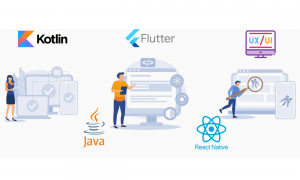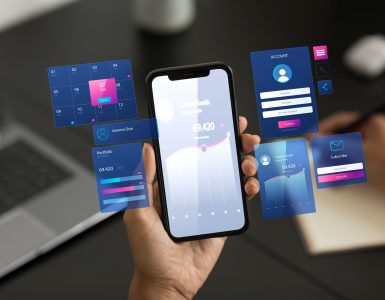The amount of mobile software used around the world is skyrocketing. No wonder that Statista predicts that worldwide revenues from mobile apps will reach $935.2 billion in 2023!

The world is moving towards 5G smartphones and tablets, becoming a complex and advanced environment for mobile app development. This somewhat uniquely shapes our lives and brings everything to the tip of our fingers.
The trend is only expected to grow in the future, creating a demand for mobile application developers in the IT industry. Companies across various domains and industries will seek highly skilled mobile developers to build successful applications. Also, with mobile app development being so lucrative as a career, mastering what you already know, as well as learning and adapting to new technologies, is extremely important.
If you’re an aspiring developer, you may be wondering what skills are required to develop eye-catching Android apps. This one’s for you. In this blog, we are adding a comprehensive list of the most key skills to learn for developers in 2022-23.
Top skills mobile devs need
Being able to program in multiple languages
Mobile apps have become increasingly sophisticated over the last decade, with frameworks like React Native and Flutter becoming essential tools for building native applications for both iOS and Android.
Given the continuous advancement of mobile application development, knowing different programming languages is crucial. The range of programming languages is wide, with some languages used in specific contexts. If you are new to app development, there are many options available to you. Most popular ones include Java and Kotlin for Android development and Swift for iOS. As you become more adaptable, you will be able to master any new technology you encounter.
Develop cross-platform development skills
The goal of cross-platform development is to create a single program that functions identically across several platforms. Creating separate native apps for each platform is expensive. Where developing a cross-platform app can cover multiple end devices at lower costs because of the usage of platform-independent technologies like HTML and CSS.
Cross-platform mobile app development, also known as hybrid mobile app development, is a methodology that enables developers to create mobile solutions that are simultaneously compatible with a number of platforms and operating systems (Android, iOS, and Windows).
Unit Testing Best Practices
Unit testing is the process of testing individual units of source code to determine if they are fit for use. Unit tests can be performed by the programmer or by an automated tool, such as the JavaScript assertion library Jest. They are the most important and foundational techniques in software development, because they can help you detect errors before they break your application and prevent them from getting worse over time.
Unit tests should be written in plain English (or natural language) so that anyone reading them understands what they’re doing and why it was done that way. This helps keep things organized, as well as gives more clarity around expectations around each particular function/method being tested.
Clean Architecture
As you’ve probably heard, “clean architecture” is an approach to software design that emphasizes simplicity and separation of concerns. It’s also known as “Functional Reuse,” or “Clamorous Coding.” The idea behind this approach is that most applications can be broken down into smaller pieces, each with its own responsibility.
Each piece also has clear boundaries, so it knows what it should do and when it should do it (and not do it). And by breaking down your code into reusable modules like this, you’ll save time because there will be fewer lines of code in each file, which means more time spent on your actual application development instead of learning how to use frameworks!
MVVM, MVP (Architecture Patterns)
MVVM is a model-view-viewmodel pattern. It’s one of the most popular patterns in web development, and it’s used to build applications that are flexible and easy to change. In an MVP architecture, an application’s UI is completely separated from its logic, allowing it to be mocked more easily and run unit testing more efficiently.
In addition to providing modularity, testability, and a cleaner and more maintainable code base, it separates view layer development from the rest of the pattern. This makes it easier for users who aren’t familiar with JavaScript, HTML5, or CSS3, as well as developers who need more control over how their code works across different platforms or environments.
An understanding of UX/UI
The term “UX design” refers to “user experience design,” whereas UI stands for “user interface design.” Both aspects are important to a product and work together. Their roles might be quite different, referring to very different aspects of product development and design. It is imperative, however, for app owners to create a high-quality UX/UI design for their apps, with thorough research and prior planning, to understand the needs of their users and solve the problem they intend to solve.
Since engaging content and easy navigation are the hallmarks of a great design and customer experience, the need for an intuitive UX and UI grows even stronger. Majority of app users today expect a highly engaging and responsive application that is also simple to use. Hence, learning the basics of UI and UX design can give you a competitive advantage in the long run.
Writing and researching skills
We are concerned a lot about learning the hard skills of programming, designing amazing apps, learning, testing stages, and debugging skills to ensure application success with technological advancements. But no one mentions soft skills – such as communication through writing and researching skills – which are important during and after development. It is crucial for any developer interested in developing a successful app to identify market trends, user preferences, and the features integrated into other successful apps. While writing is one of the must-have skills for developers looking to make it big in the field, soft skills can come in handy when writing use cases, test cases and emails, etc.
Critical thinking
Whether you’ve already established your career in the tech industry, or you’re just dipping your toes into learning to code,.there are several soft skills coders need to set themselves apart. Critical thinking involves looking closely at the information in front of you and using it to make a logical decision. Rather than relying on their assumptions or intuition, critical thinkers use critical, logical and methodical thinking.
While developing an app, taking an analytical approach that involves asking questions, uncovering false assumptions, and evaluating various approaches to the problem are some of the major elements involved in thinking critically.
Conclusion
Developing a mobile application is a process that involves several stages to ensure the final app is of the highest quality and most efficient. As we saw in this article, there are many different options when it comes to learning these technologies. For that, almost every mobile app development company will tell you to learn essential skills to develop a mobile application.
But to get the most out of your mobile development skills, you’ll need to have a solid understanding of each framework and its strengths, and you’ll need to work on soft skills for a lucrative development process.






Add comment